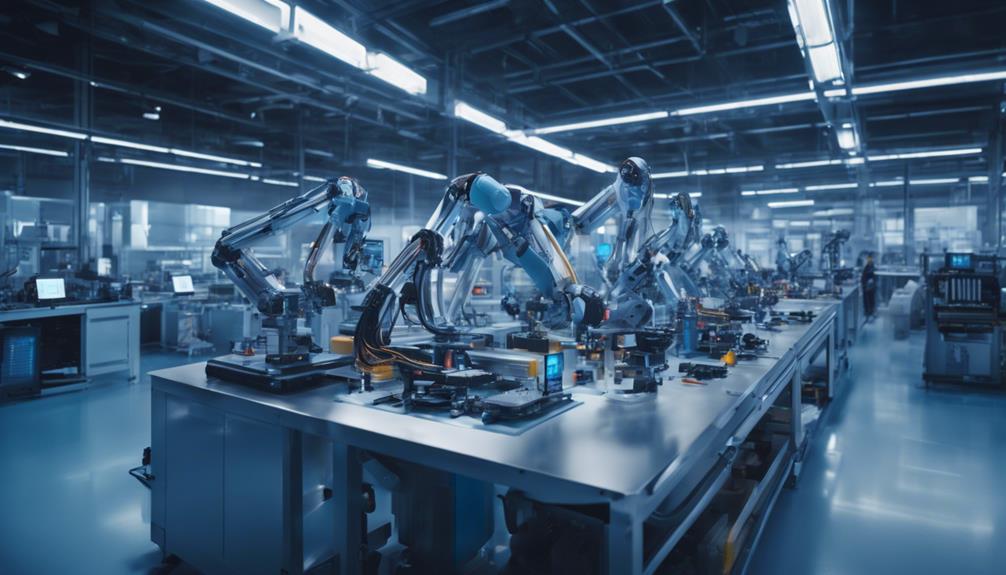I've seen how automation transforms operations, cutting costs by minimizing manual tasks and reducing errors. It works around the clock, driving substantial savings. Automation enhances accuracy and quality, reducing rework needs and operational expenses. Scalable processes guarantee minimal additional effort as businesses grow. It intelligently allocates resources, optimizing efficiency and boosting ROI. Improved task management means motivated employees, who are freed from tedious jobs and can focus on strategic activities. These benefits don't just streamline workflows; they offer a competitive edge and sustainable growth. Discover more to see how automation can elevate your operations.
Key Takeaways
- Automation reduces operational costs by up to 90%, significantly boosting ROI.
- Streamlined workflows through automation enhance efficiency and resource utilization.
- Automation minimizes manual errors, ensuring higher quality and customer satisfaction.
- Intelligent resource allocation through automation ensures consistent, reliable processes.
- Employees focus on strategic activities, leading to increased job satisfaction and productivity.
Increased Efficiency
Automation dramatically boosts efficiency by eliminating manual, repetitive tasks and enabling faster task completion. By doing so, it allows organizations to operate around the clock, driving substantial cost savings and reducing operational costs.
In my experience, automation enables organizations to achieve up to 90% cost savings, which not only improves efficiency but also provides a significant competitive advantage. Companies can reallocate resources more strategically and focus on innovation rather than routine tasks.
Deloitte's survey highlights that 61% of businesses met or exceeded their cost reduction goals with automation, underscoring its impact. This approach fosters sustainable growth by minimizing the need for contractors and lowering overall operational expenses, paving the way for long-term success.
Enhanced Accuracy
While efficiency gains are paramount, the enhanced accuracy brought by automation is equally transformative in achieving substantial cost savings and operational excellence. Automated processes guarantee improved quality by reducing manual errors, which directly translates to up to 90% reduction in operational costs.
This accuracy minimizes rework, maintaining consistent quality standards and reducing costs. Enhanced accuracy not only fosters cost reduction but also boosts customer satisfaction, as clients receive reliable and high-quality products or services. The consistent performance of automated systems builds a positive brand reputation, leading to increased customer loyalty.
Scalability Benefits

One can't overlook the strategic advantage of scalability that automation brings to a growing enterprise. Automation technologies enable processes to be replicated across the organization with minimal additional effort and cost, which is vital for competitive organizations aiming to expand.
The scalability benefits are particularly evident in decentralized structures where uniformity and quality need to be maintained across various branches. By increasing efficiency and enhancing decision making, automated processes guarantee consistency and reliability. This leads to exponential return on investment as businesses scale their operations seamlessly.
Consequently, scalability in automation not only supports business growth but also ensures higher efficiency levels, making it a strategic asset in today's fast-paced, innovation-driven market.
Cost Reductions
When I look at cost reductions through automation, I see two critical areas: minimizing labor expenses and optimizing resource utilization.
By automating repetitive tasks, we can greatly reduce labor costs, reducing the need for manual intervention.
Additionally, better resource utilization means we're using our assets more efficiently, leading to further cost savings.
Labor Expense Minimization
Automation greatly reduces labor expenses by streamlining manual tasks and optimizing resource allocation. By implementing automation, we can achieve significant cost reductions and enhance operational efficiency.
Deloitte's survey indicates that 61% of companies have met or exceeded their cost reduction expectations through automation initiatives. Replacing manual tasks with automated processes not only minimizes labor expenses but also leads to substantial cost savings. Moreover, automation reduces reliance on costly contractors, which directly contributes to overall cost-effectiveness.
Strategically viewing automation as a cost reduction tool enables businesses to maximize efficiency and achieve significant savings. As we aim for innovation, focusing on automation's role in minimizing labor expenses is essential for driving sustainable growth and operational excellence.
Resource Utilization Efficiency
By extending our focus beyond just labor expenses, we can harness automation to optimize resource utilization and achieve remarkable cost reductions.
Automation tools replace outdated technologies and eliminate manual tasks, driving significant efficiencies and cost savings. A Deloitte survey found that 61% of organizations met or exceeded their cost reduction expectations through automation, underscoring its strategic value.
By automating processes, we reduce reliance on contractors, leading to long-term cost reductions. Viewing automation through the lens of cost savings helps us achieve efficiency gains and optimize resource utilization.
This holistic approach not only enhances operational efficiency but also positions our business for sustained growth and innovation.
Resource Optimization

When I consider resource optimization, I focus on how automation streamlines workflow processes and allocates resources intelligently. By reducing operational overhead and minimizing human errors, we can achieve significant cost savings and efficiency gains.
This strategic approach directly enhances ROI, demonstrating the tangible benefits of adopting automation.
Streamlined Workflow Processes
Implementing automated systems drastically trims operational costs and reallocates resources more efficiently, driving substantial improvements in workflow processes. Automation enhances streamlined workflows by reducing operational costs up to 90%, optimizing resource utilization, and minimizing costly errors. This efficiency results in significant cost savings and higher productivity levels. Automated systems guarantee tasks are completed faster, allowing businesses to focus on strategic and high-value activities.
Here's a visual representation:
| Benefit | Impact |
|---|---|
| Cost Savings | Reduction of operational costs |
| Resource Utilization | Elimination of waste |
| Error Minimization | Fewer costly mistakes |
| Enhanced Productivity | Higher efficiency in workflows |
Intelligent Resource Allocation
Automation empowers companies to precisely allocate resources, ensuring maximum efficiency and substantial cost savings. By leveraging data, I can implement intelligent resource allocation strategies that optimize resource utilization, reducing waste and enhancing productivity.
Automation minimizes the risk of costly errors, leading to significant cost savings and improved operational efficiency. Through resource optimization, I can streamline workflows, ensuring resources are deployed where they're needed most. This direct approach to efficient resource allocation translates into higher productivity levels and a maximized return on investment.
In a world that demands innovation, harnessing automation for resource optimization becomes a strategic imperative, enabling businesses to stay competitive and achieve sustainable growth.
Reduced Operational Overhead
By leveraging automation, businesses can dramatically cut operational overhead, leading to substantial cost savings and streamlined efficiency. Automation reduces operational costs by up to 90%, ensuring significant savings.
Through resource optimization, automation eliminates waste and allocates resources more efficiently. This not only minimizes the risk of costly errors but also enhances overall efficiency. When resources are allocated effectively, the direct outcome is an increased ROI.
Reducing operational overhead with automation translates to lower operational costs and less manual intervention, which further boosts efficiency. The strategic use of automation in resource optimization positions businesses to achieve superior cost management and operational excellence, fostering an environment ripe for innovation and growth.
Data-Driven Insights
Real-time insights and analytics derived from automation empower businesses to make data-driven decisions that enhance efficiency and profitability. By leveraging advanced automation solutions, including artificial intelligence (AI) and machine learning (ML), I can transform raw data into actionable insights.
This capability allows me to identify growth opportunities and mitigate risks more effectively. Real-time analytics guarantee that I've accurate and up-to-date information, enabling informed decisions that drive strategic objectives.
Automation provides a competitive advantage by delivering precision and speed in data analysis, allowing me to stay ahead in a rapidly evolving market. Ultimately, embracing these technologies helps streamline operations, reduce waste, and maximize ROI, making data-driven decisions an essential part of my business strategy.
Competitive Edge

Gaining a competitive edge through automation isn't just about cutting costs; it's about enhancing productivity, improving quality, and staying ahead in the market.
By deploying automated systems and integrating artificial intelligence (AI) and machine learning, I can achieve increased efficiency and streamline operations. This not only drives significant cost savings but also boosts customer satisfaction through faster, more reliable service.
In sectors like healthcare and finance, automation enhances patient care and optimizes back-office processes, giving businesses a strategic advantage.
Effective manufacturing strategies also benefit from automation, reducing operational costs while maintaining high-quality output.
Ultimately, embracing automation transforms business performance, providing a sustainable competitive edge and ensuring long-term success in an ever-evolving marketplace.
Employee Satisfaction
Automation greatly enhances employee satisfaction by removing tedious and repetitive tasks from their daily routines. By eliminating manual work, automation allows employees to focus on more engaging and strategic activities, greatly boosting job satisfaction.
Studies indicate that 85% of employees feel more satisfied when automation reduces their workload. Streamlined workflows not only increase efficiency but also elevate employee morale, leading to greater job satisfaction. This, in turn, promotes higher retention rates, which contribute to cost savings for the company.
Strategically, integrating automation into business processes creates a more motivated and efficient workforce, directly impacting overall productivity and profitability. Therefore, automation is a pivotal tool for enhancing employee satisfaction while achieving broader organizational goals.
Frequently Asked Questions
How Can Automation Increase Efficiency?
Automation increases efficiency by optimizing workflows, prioritizing tasks, and reducing errors. It allows for better resource allocation, process standardization, and time management, creating a streamlined operation that strategically enhances overall productivity and innovation.
What Is ROI in Automation?
ROI in automation involves an ROI calculation based on automated metrics. I focus on investment returns and profitability analysis to meet ROI benchmarks. The automation benefits drive strategic decisions to enhance efficiency and maximize financial gains.
How Can Automation Help You Better Save Money?
Automation helps me save money through maintenance reduction, error minimization, and labor optimization. It also improves inventory management, energy conservation, and resource allocation, ensuring my operations are efficient and strategically aligned with cost-saving innovations.
How Does Automation Increase Costs?
Automation amplifies costs through implementation costs, training expenses, maintenance fees, integration challenges, software licensing, and downtime risks. These factors necessitate strategic planning to guarantee that the benefits outweigh the initial financial and operational investments.
Conclusion
To sum up, automating business processes isn't just a future trend—it's a current necessity.
A compelling statistic reveals that companies using automation see up to a 15% increase in operational efficiency.
This efficiency translates into significant cost savings and scalable growth opportunities.
By optimizing resources and leveraging data-driven insights, businesses not only gain a competitive edge but also enhance employee satisfaction.
It's clear: automation is a strategic move that delivers substantial ROI.





